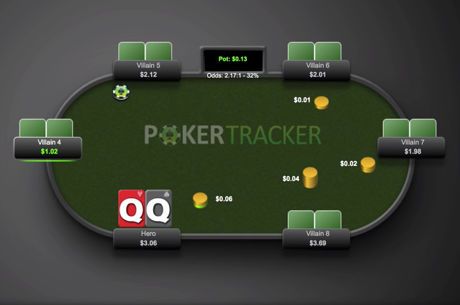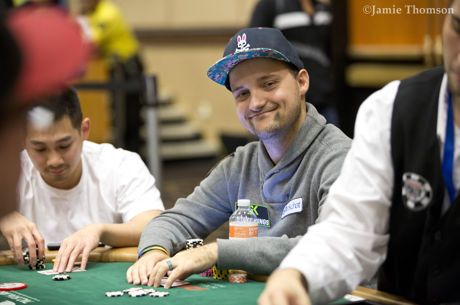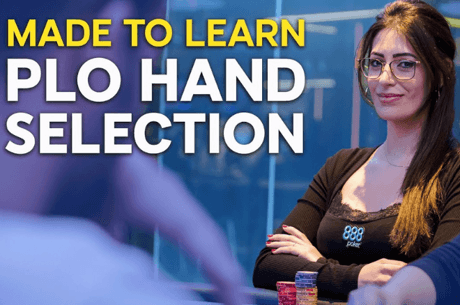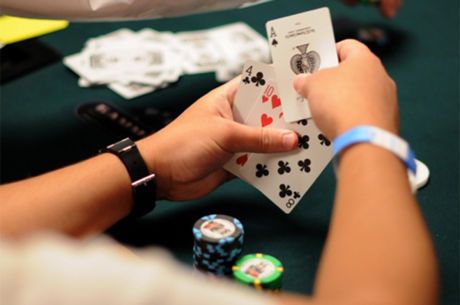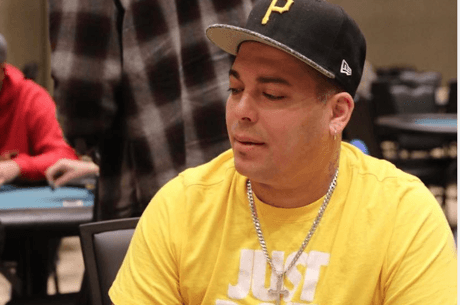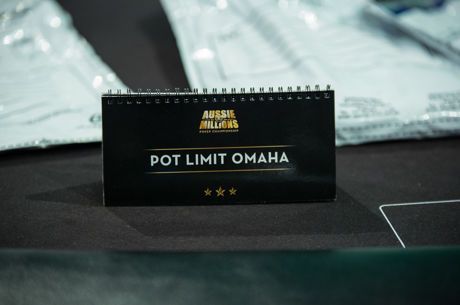Tommy Angelo Presents: Waiting for Straighters, Part II - Strategy Merits in PLO
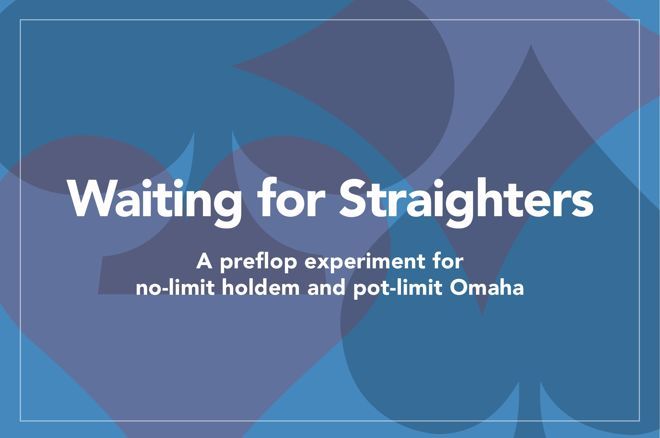
Introduction to Episode 4
In hold'em, a straighter is a hand that can flop a straight. 6-2 is a straighter. 7-2 isn't. In pot-limit Omaha, a straighter is a hand with no pairs, no aces, and no more than two gaps. J-9-8-6 has two gaps, so that's a straighter. J-9-8-5 has three gaps, so it's not.
Waiting for straighters does not mean wait until you get a straighter and then play it. It means wait for a straighter, at least, and then maybe play it. In other words, fold the non-straighters. That's the gist of this article.
This episode is about how and why to apply WFS to PLO.
Strategic Merits of WTS in PLO
Wraps and Equity
In hold'em, with 9-8, there are three ways to flop an open-ender using both hole cards. With 9-7, there are two ways, and 9-6 has one way. The same is true in PLO. Every pip matters. 9-8-7-6 has better wrap-flopping potential than 9-8-7-5. And J-T-8-6 has better wrap-flopping potential than J-T-8-5.
And when we flop a wrap, we very often get to cash in the full equity of our starting hand by seeing the river. This is big. The value of a hand is not only about how it performs in an equity calculator. It's also about how it plays. It's about the hand's ability to correctly see the river, because only then does a hand realize its full statistical potential. 9-8-7-5 will see the river more often than a hand like Q-J-7-5, and that stat alone gives 9-8-7-5 additional worth, above and beyond its straight-making potential.
When a straighter flops a wrap, you see full-board runouts. This is the hidden value. It's like the dark energy of Omaha.
The Straighter Edge
Waiting for straighters creates a permeating edge, like the house edge at roulette, or like being taller than your opponent at basketball. You have a simple advantage that's just there, all the time, independent of skill or luck or the weather.
Which is not to say that you don't have to be skilled at basketball to win at basketball. You do. Height is not enough. But it sure helps. As does having better cards, on average, than your poker opponents.
Freerolls, Fold Equity, and the Secret Sauce
Freerolls are the best and drawing dead is the worst. The secret sauce of the professional survivor is to glom onto freerolls and to take precautions against drawing dead and nearly dead. WFS is the secret ingredient in the secret sauce. It not only tips the stats in your favor, it also cultivates a strong range in your opponents' minds, and you gain fold equity. Fold equity is when you bet and they fold. Fold equity is where half the grinder's profit comes from. The other half comes from having better cards. And the other half comes from consistency. WFS does all of the above. No lapsing. No pendulum. No problem.
Why to Do It
As with hold'em, WFS at PLO is not about following a one-size-fits-all starting-hand chart. It's not about theoretical correctness. It's about drawing new lines that you decide on, and then intending to stay within those lines for a few sessions at least because (1) you want to see if you can, and (2) it might improve your score.
It's Easier
Good starting hands — compared to lesser hands — make the turn and river easier to play. The decisions are more perceivable, less ambiguous, and more fun.
Chances are high that waiting for straighters would lower your VPIP, and if that's the case, here are the potential benefits:
- Improve the long-term stability of your game. More on that later.
- Improve the short-term stability of your game. More on that later, too.
- As mentioned, it'll increase your squeezer vig, also known as fold equity.
- Fewer marginal situations means fewer tricky spots means less guessing means more confidence and more on that later.
- Less exertion-per-hand means more stamina which means playing more tables online and playing longer live sessions with less depletion.
It's Safe
WFS at PLO is a safe approach for beginners, similar to playing super tight before the flop when learning no-limit hold'em. When I teach beginners how to play no-limit in a public poker room, I recommend that they play nothing but pocket pairs and A-K at first, from all seats. The reason for doing so is to log lots of hours at the table to gain table experience, while minimizing the amount you lose per hour by playing very few hands, while at the same time minimizing your strategic disadvantages postflop by playing only those starting hands that result in the simplest postflop decisions.
And then, over time, the preflop ranges expand, safely, comfortably.
In the same way, WFS at PLO is a safe way to learn the game. The difference is, at PLO, you don't ever need to expand your ranges to be a consistent winner.
(But you do have to play consistently superb postflop poker to be a consistent winner, no matter what your preflop ranges are.)
Stretching the Lines at PLO
Waiting for straighters is strictly defined, but it doesn't have to stay that way. You can use it as a guideline, a baseline, even a lifeline, that you intend on stretching, as appropriate, in battle.
For example, you might choose to play some of the best non-straighters when you are in one of the three situations where you know at the outset that you will be last to act throughout the hand: (1) on the button, (2) big blind vs. small blind, (3) you are in the cutoff and the button telegraphs a preflop fold. In those spots, you might decide to play, say, any hand with three-to-a-Broadway (K-Q-J-x, K-Q-T-x, K-J-T-x, Q-J-T-x) even though they have a dangler. Or you might play J-T-9-2, on the strength of having three-in-a-row.
It's natural and necessary to mix some gray into the black-and-white picture I've painted, because until you run your own tests, you'll know nothing about the scope or effect of WFS on your game.
Reciprocality
Reciprocality is about creating profitable differences between you and your opponents on purpose. If you get better sleep than they do, that's a profitable difference. If you tilt less than they do after getting multiple sets cracked and losing big for five days in a row, that's a profitable difference.
What if one of the things you did differently on purpose was to usually have the best hand on every street?
By "usually" I mean, "more than half the time." And by "best hand" I mean, "a hand that is favored in a runout against each opponent." Let's say you play 1,000,000 streets, and you go back and do a heads-up runout against every hand you faced from each of the streets you faced them. If you would win more runouts than you lose, that's what I mean by usually having the best hand on every street.
There are three types of PLO hands:
- Hands with 1 pair, 2 pair, trips, or quads
- Hands with 1 ace and no pairs
- Hands with no aces and no pairs
To play a style of poker that could be called My Hand's Better Than Your Hand, you wait for the best hands in all three categories. Besides the obvious statistical advantages of doing so, you are also now powered by dark energy in all three categories. (See Wraps and Equity.)
Let's look at what happens when you and your opponent both have Group 3 hands.
If you always have a straighter, and your opponent plays a wider range, then you will usually have the best hand before the flop. When both of your hands connect with the flop, then you will have the best hand on the flop, and on the turn, and on the river, more often than they do. And when you share 2 or 3 cards with your opponent, you will sometimes hear the F-word. No, not that F-word, although you'll hear that too. The F-word I'm talking about is:
Freeroll
When waiting for straighters, you will sometimes play J-T-8-6, and never play J-T-8-5. Let's pit those hands against each other in a big pot…
You have J-T-8-6 and your opponent has J-T-8-5. The flop is:
9-7-4
You both play aggressively on the flop and you get all-in on the flop. The turn is a blank:
9-7-4-4
On the river, if any card but a 5 comes, it's a split pot. When a 5 comes, you enjoy a sip of the secret sauce. It's quite tasty, and worth the wait.
And those two starting hands differed by only one pip. Take a hand like J-T-9-7 up against a typical, somewhat attractive non-straighter such as Q-J-6-5, and even more good times lie ahead.
Sometimes you'll be outgunned. Let's give you J-T-8-6, and your opponent has T-9-8-7. You are poised to lose money on this hand if you hit the flop because most of the flops that hit your hand will hit your opponent's hand even harder. And the reason you're behind is because your hand has more gaps than his. You have 2 gaps and he has 0.
It happens, even while waiting for straighters. You get out-gapped. The idea behind WFS is to get out-gapped less often than you do now, and to out-gap the opposition more often than you do now. There's you, with never more than two gaps, and then there's the rest of the world, oftentimes with three or more gaps. That right there is the straighter edge.
Do the math, and you end up with this equation:
USUALLY BEST x THE REST OF YOUR LIFE = A VERY BIG NUMBER
The next episode of Waiting for Straighters is called "Using WFS to Tame Tilt, Plug Leaks, and Reduce Fear of Self." And that's where the story ends, with the promise of reduced dissatisfaction. Waiting for Straighters is available in ebook and audiobook at all the usual places.
- Part I - Discovery (Episode 1)
- Part II - No-Limit Hold'em (Episode 2)
- Part II - Pot-Limit Omaha (Episode 3)
- Part III - Taming Tilt and Plugging Leaks (Episode 5)

World-class coach and author Tommy Angelo is now offering poker pain relief to everyone. You can schedule a call to talk to Tommy about bad betting, bad quitting, bad tempers, or whatever else is hurting your game. Just go to tommyangelo.com. Angelo's first book, Elements of Poker, was called "the seminal poker text of the 21st century" by The London Times, and it has revolutionized the way serious players approach the game.
In this Series
- 1 Tommy Angelo Presents: Waiting for Straighters, Part I - Discovery
- 2 Tommy Angelo Presents: Waiting for Straighters, Part II - No-Limit Hold'em
- 3 Tommy Angelo Presents: Waiting for Straighters, Part II - Pot-Limit Omaha
- 4 Tommy Angelo Presents: Waiting for Straighters, Part II - Strategy Merits in PLO
- 5 Tommy Angelo Presents: Waiting for Straighters, Part III - Taming Tilt and Plugging Leaks

